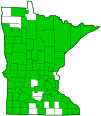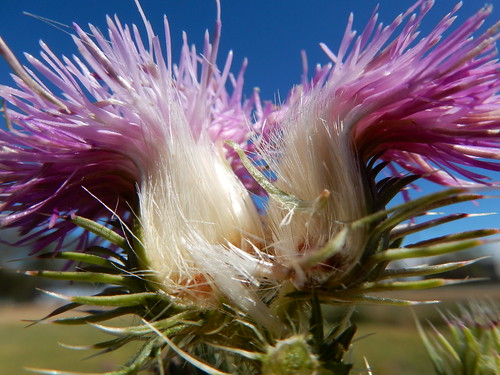plumeless thistle
(Carduus acanthoides ssp. acanthoides)
Conservation • Weed • Description • Habitat • Ecology • Use • Distribution • Taxonomy
|
|
|||||||||||||||||||
Description |
Plumeless thistle is a 12″ to 60″ tall, erect, biennial forb that rises on a single stem from a long, stout, fleshy taproot. In the first year the plant appears as a dense rosette of basal leaves. In the second year it sends up a single flowering stem. The stems are erect, ribbed, and freely branched near the top. They may be hairless or lightly covered with soft, long, unmatted hairs. They have small appendages (wings) running the length of the stem and branches except just below the inflorescence. The wings are interrupted, not continuous for the length of the stem. They are irregularly lobed and wavy, each lobe tipped with relatively hard, straw-colored spines. Basal leaves are lance-shaped to elliptic in outline and 4″ to 8″ long. They are deeply lobed (pinnatifid). The lobes are irregular and also toothed or lobed. The ultimate lobes or teeth are tipped with relatively hard, straw-colored spines. The upper and lower surfaces are green and sometimes hairless, usually sparsely covered with long, soft, shaggy, unmatted hairs mostly along the main veins. Stem leaves are similar, alternate, and stalkless, becoming smaller and less divided as they ascend the stem. The base of the leaf continues down the stem and forms a pair of spiny wings. Upper stem leaves are lance-shaped and unlobed. The inflorescence is a usually a single flower head, sometimes a cluster of 2 to 5 flower heads, held erect at the end of the stem and each branch. The heads may be unstalked or at the end of a long, spiny-winged stalk. The whorl of bracts at the base of the flower head (involucre) is ⅜″ to 1″ in diameter and in the shape of half of a sphere. The bracts of the involucre are narrowly lance-shaped, erect or loosely spreading, and no more than 1 ⁄16″ wide. The middle and outer bracts have long spines at the tip. The flower heads are ½″ to 1″ wide. They have numerous purple, tubular flowers. The fruit is a golden to brown, 1 ⁄16″ to ⅛″ long achene with whitish, minutely barbed hairs attached. |
Height |
12″ to 60″ |
Flower Color |
Purple |
Similar Species |
Musk thistle (Carduus nutans) is a larger plant. The basal leaves are longer, up to 16″ long. The upper side of the leaf is hairless. The flower stalk is usually naked, not winged, but sometimes has a few small, scattered bracts. The flower head droops ninety degrees when mature. The flower heads are much larger, ¾″ to 2¾″ wide. |
Habitat |
Pastures, disturbed areas, roadsides. |
Ecology |
Flowering |
July to October |
Pests and Diseases |
|
Use |
|
Distribution |
||
|
Sources 2, 3, 4, 5, 7, 22, 24, 28, 29, 30. Minnesota Department of Agriculture Plants, Noxious and Invasive Weeds, Plumeless thistle |
|
| 5/17/2025 | ||
Nativity |
||
Native of Asia and Europe. Introduced and naturalized in North America. |
||
Occurrence |
||
Common |
||
Taxonomy |
|
Kingdom |
|
Division |
Tracheophyta (Vascular Plants) |
Subdivision |
Spermatophytina (Seed Plants) |
Class |
|
Order |
Asterales (Sunflowers, Bellflowers, Fanflowers, and Allies) |
Family |
Asteraceae (Sunflowers, Daisies, Asters, and Allies) |
Subfamily |
Carduoideae (thistles and allies) |
Tribe |
Cardueae |
Subtribe |
Carduinae (thistles and burdocks) |
Genus |
Carduus (plumeless thistles) |
Species |
Carduus acanthoides (broad-winged thistle) |
Subordinate Taxa |
|
|
|
Synonyms |
|
Carduus acanthoides ssp. polyacanthus Carduus acanthoides var. albiflorus Carduus acanthoides var. involucratus Carduus acanthoides var. microcephalus Carduus acanthoides var. ochranthus Carduus acanthoides var. polyacanthos Carduus acanthoides var. polyanthus Carduus acanthoides var. submitis Carduus acanthoides var. thessalus Carduus acuminatus Carduus camporum Carduus crispus ssp. acanthoides Carduus crispus var. litigiosus Carduus fortior Carduus murfatlarii Carduus palatinus Carduus polyacanthos Carduus polyanthos Carduus ruderalis Carduus sinuatus Carduus thessalus Carduus vranjanus Onopyxus acanthifolius Polyacantha acanthoides |
|
Common Names |
|
plumeless thistle spiny plumeless thistle spiny plumeless-thistle welted thistle |
|
Glossary
Bract
Modified leaf at the base of a flower stalk, flower cluster, or inflorescence.
Glaucous
Pale green or bluish gray due to a whitish, powdery or waxy film, as on a plum or a grape.
Involucre
A whorl of bracts beneath or surrounding a flower, flower head, or flower cluster.
Pinnatifid
Deeply cut, more than half way to the midrib but not to the midrib, into lobes that are spaced out along the midrib; the lobes do not form separate leaflets.
Sepal
An outer floral leaf, usually green but sometimes colored, at the base of a flower.
Wing
A thin, flat, membranous, usually transparent appendage on the margin of a structure.
Visitor Photos |
||
Share your photo of this plant. |
||
This button not working for you? |
||
Luciearl |
||
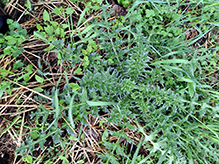 |
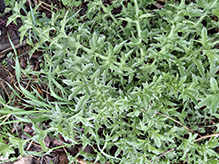 |
|
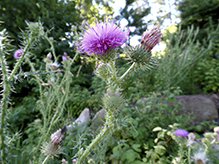 |
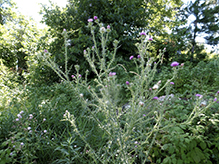 |
|
MinnesotaSeasons.com Photos |
||
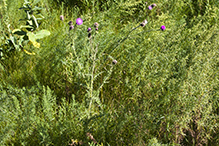 |
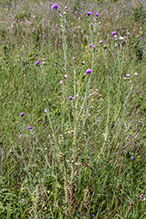 |
|
Plant |
||
|
||
|
||
|
Plant |
|
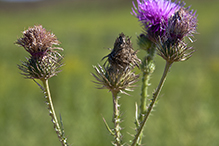 |
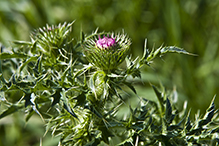 |
|
Inflorescence |
Inflorescence |
|
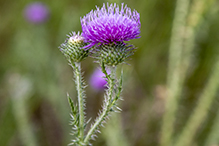 |
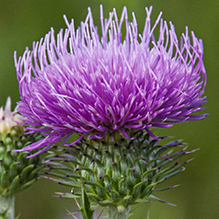
|
|
Inflorescence |
||
|
||
|
||
|
Flower head | |
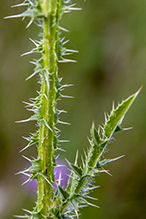 |
||
Stem |
|

Slideshows |

Visitor Videos |
||
Share your video of this plant. |
||
This button not working for you? |
||
|
Other Videos |
||
Plumeless Thistle, identification of the Wisconsin Invasive Species Carduus acanthoides |
About
Uploaded on Jan 31, 2011 This is part of a series of videos providing key characteristics for the identification of invasive plants listed in Wisconsin's invasive species administrative rule NR 40. These videos are produced by Dr. Mark Renz of the University of Wisconsin-Madison. For more information on invasive plants and invasive plant management in Wisconsin visit http://fyi.uwex.edu/weedsci or http://ipcm.wisc.edu/Publications/WeedSciencepublications/tabid/116/Default.aspx |
Spiny Plumeless Thistle (Carduus Acanthoides) - 2012-06-25 |
About
Published on Jun 27, 2012 Carduus acanthoides is a species of thistle known as the spiny plumeless thistle and welted thistle. ------------------------- |
Weed Management: Thistles |
About
Uploaded on Mar 31, 2011 Dr. William Witt of the University of Kentucky discusses managing four thistles--musk, plumeless, bull, and Canada thistles--in horse pastures. |

Visitor Sightings |
||
Report a sighting of this plant. |
||
This button not working for you? |
||
Luciearl |
Location: Fairview Twp. |
 |
| Luciearl 7/25/2020 |
Location: Cass County |
 |
MinnesotaSeasons.com Sightings |
||

|
Created: 12/28/2011 Last Updated: © MinnesotaSeasons.com. All rights reserved. |
